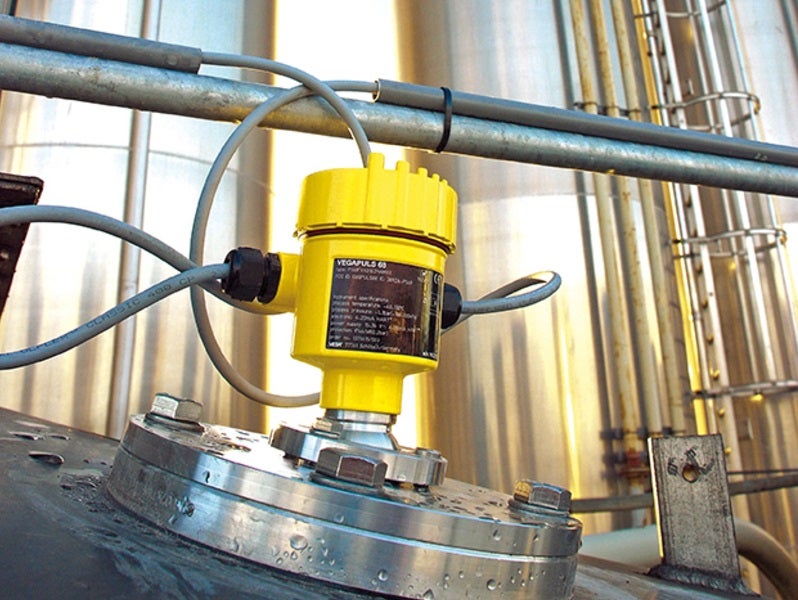
Continuous level measurement of liquid and bulk solids is essential to prevent tanks and silos from overflowing or falling under minimum capacity. A number of level measurement techniques are used across mining and water industries.
Accurate level measurements improve efficiency across the production line and ensure that product quotas are met when it comes to shipment, protecting both equipment and profits.
“What operators want is for their mine to run as smoothly and efficiently as possible and to maximise their output to sell to their customers,” explains John Leadbetter, managing director of Vega, specialists in process instrumentation solutions. “They have customer demands and deadlines to meet and any downtime is time not making money.”
Radar and guided wave process instrumentation
Radar level measurement is an effective technique that provides reliable results in adverse environments. Radar-based instrumentation measures levels using high-frequency radio waves that detect the distance from the transmitter and the surface of the liquid by timing how long it takes for the electromagnetic waves to travel. As radio waves can be utilised in high temperatures, high pressures and high humidity, they are a popular choice for a number of applications and industries.
VEGAPULS products from Vega are radar sensors used for level measurement of liquids or bulk solids. The company’s portfolio provides a comprehensive range of continuous non-contact radar sensors for a variety of applications. Sensors such as the VEGAPULS C 11, C 21, C 22 and C 23 are ideal for simple water industry applications, including level and flow measurements, whereas the VEGAPULS 11, 21 and 31 are designed for standard applications such as measuring liquid levels in storage modules.
The VEGAPULS WL 61, 61, 62, 64, 65 and 66 are specifically designed for use in extreme temperatures or dealing with aggressive liquids, while the VEGAPULS 67, SR 68, 68 and 69 are suitable for continuous level measurement of bulk solids.
Guided wave radar measurement, also known as signal runtime measurement or time domain reflectometry (TDR) sensors, feature a waveguide probe which extends inside the tank. Radar pulses are sent down the probe to determine liquid levels in the tank by calculating how long it takes to make contact with the product and correlating this with distance.
The VEGAFLEX range offers reliable level measurement using this technique. VEGAFLEX 81 is a universal TDR for all liquids, VEGAFLEX 82 is designed for use with light bulk solids, VEGAFLEX 83 is ideal for aggressive media or applications with high hygiene requirements, and the VEGAFLEX 86 is manufactured to be robust and reliable in adverse process environments.
There are a number of non-contact techniques available for process instrumentation; from radar, ultrasonic and radiation-based sensors to capacitive and hydrostatic pressure monitoring.
Ultrasonic level measurement
Ultrasonic level measurement is an alternative non-contact technique. The transmitter emits ultrasonic pulses and calculates levels based on the time from transmission to contact with the product.
Vega’s VEGASON 60 range can be used to measure liquid or bulk solids in open containers.
Capacitive level measurement
The capacitive level measuring technique uses a probe rod and the tank wall to form a capacitor. The amount of liquid or bulk solid in the tank effects capacitance, which is detected by a sensor to calculate product level.
The VEGACAL 60 range covers rod, cable and double rod varieties and are insulated with polytetrafluoroethylene (PTFE), fluorinated ethylene propylene (FEP) or ceramic.
Hydrostatic level measurement
The hydrostatic level measurement technique monitors hydrostatic pressure to calculate any changes in liquid level. The submerged instrumentation provides reliable results in adverse conditions or in applications with potential foaming or obstructions.
The VEGABAR 80 range is available with metallic or ceramic cells. The VEGABAR 81 is fitted with a chemical seal for use in high pressures and the VEGABAR 83 is specifically designed for applications with high pressures.
Radiation-based level measurement
Radiation-based (or radiometric) level measuring comprises a low radiation isotope encased in source holder, which is mounted on the side of a storage container or pipe. Energy is collimated in the direction of a detector located at the other side of the vessel. The amount of product inside the container or pipe affects the amount of energy that can be passed to the sensor, so changes in detected energy are used to calculate liquid/bulk solid levels.
VEGA’s FIBRETRAC 31 and 32 are radiometric sensors for liquids and bulk solids even in extreme temperatures.



